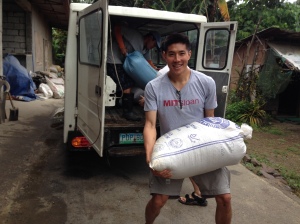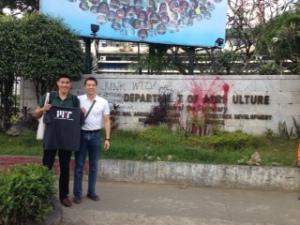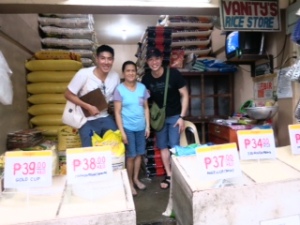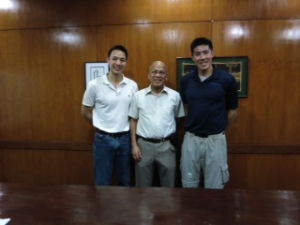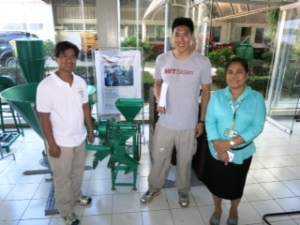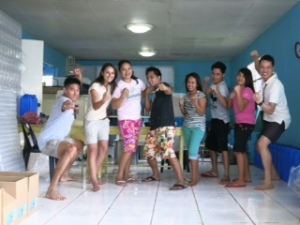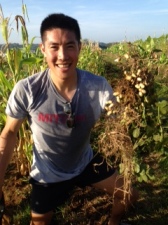(IAP ’14) Christopher Tang, G
Christopher Tang (G Management) Chris researched smallholder rice farming in the Philippines over IAP and tried to answer two questions: first, why are these farmers poor? And second, what strategies exist for helping them out of poverty? During his visit with Zech Lung (another PSC Fellow), he met an integrated rice producer that did a solid job of raising farmer incomes while also creating a premium, nutritious product. The duo also visited government ministries, rice research institutes, and a social agribusiness incubator. During the trip, he also developed an interest in sustainable coffee and cacao after meeting contacts there.
Smallholder farmers more as suppliers, not customers (22 Feb 2014)
It’s been several weeks since our trip ended in the Philippines. I’m still in awe of how rewarding and eye-opening the trip was. During these weeks, my opinion for helping raise the incomes of smallholder farmers has evolved from viewing smallholder farmers as customers to instead seeing them more as suppliers for food companies.
First, let me back up a few months. Our original plan when starting back in October was to start an organization to help raise the incomes of smallholder farmers by a) selling them rice dryers and storage bags on credit, b) training them on how to use this equipment, and c) connecting them to large, institutional buyers.
But our model made a major assumption: that all rice farmers are entrepreneurs and want to raise their incomes. They aren’t and sometimes they’re not interested in raising their incomes. Our interview with Mr. Estrella, Chairman of his rice cooperative, was a case in point. When we interviewed the fit and healthy 70-year old, we asked him whether he would be interested in a dryer to dry his palay and allow him to sell it to the trader for a higher price. His response is one I won’t forget. He said with a big smile and casual wave of the hand, “Why would I want to do that?!! I’m very happy selling my wet palay to the trader. After that I don’t have anything else to worry about.”
Above: Mr. Estrella, Chairman of his rice cooperative. Fittest and happiest 70-year old I’ve seen!
This was a very important point and could turn into a philosophical discussion of whether enabling a farmer to move up the value chain by drying his rice and increasing his / her income equates to a better quality of life. Through the eyes of Mr. Estrella, clearly it doesn’t.
Because of this experience, my opinion on how to help improve the livelihoods of smallholder farmers has evolved from seeing them as customers to now seeing them more as suppliers. If you can create a premium rice product and generate large market demand for it, you can pay smallholder farmers a fairer price for their wet palay using the higher margins from the sale of your product.
Embedded in this model is a method called contract farming where the buyer – in this case, assume a company – outsources the growing of rice to the farmer and often provides the seeds and other inputs to do this. It also allows for specialization: allowing farmers to do what they’re best at and like to do (i.e. just farming), while allowing the company to do the rest at an efficient and industrial scale.
On one hand, the farmer benefits as he / she has a guaranteed buyer for their product, often is paid a higher price for their crop, and also does not have to try to take out credit for their inputs. On the other hand, the company is securing its supplies for production and also is able to realize large economies of scale through bulk purchasing of inputs.
During our trip we saw a national rice champion which was doing this. First, they had a premium hybrid rice variety that commanded a price point around 70 to 80 percent higher than popular medium-quality rice. Second, they conducted contract farming and guaranteed the buyback of all the rice from the farmer. And finally, they are an integrated producer that ensures it can maintain strict quality control of its product and also prevent other parties from taking small commissions along each stage of the value chain. I have no doubt of the high potential this company has going forward. The good news is that this three-prong approach can be applied to many other crops e.g. coffee, cacao. That’s exciting and worth acting on some day.
Above: Carrying 50-kg bags of rice at the mill is harder than it looks.
The takeaways from our Philippines trip as well as the people I have met along the way has made for a truly invaluable experience. My deepest thanks go out to the Public Service Center and the IDEAS Global Challenge for funding our trip. Finally, I encourage anyone and everyone interested in pursuing an idea for which they have a passion to apply for a PSC Fellowship. It has truly been a transformative experience. Thank you!!!
Nearing the end of a fruitful trip (26 Jan 2014)
Above: At the Rocky Mountain Coffee Nursery
It’s nearing the end of our trip and I’m super satisfied with our results. For one, Zech and I haven’t killed each other yet, but more importantly we have determined that rice is not a sector we want to venture into. Instead, I’ve gotten to know better another crop that can help alleviate poverty for smallholder farmers: coffee.
What we’ve been up recently
As we wind down toward the end of our trip, our past week has been a week of meeting people to share our lessons since arriving in the Philippines and, as always, learning something from everyone.
In Manila, this week we met people from IFC, a corporate foundation, and Grameen Foundation. At the end of the week we finally made a visit to the International Rice Research Institute (IRRI) and also visited a high-altitude coffee plantation in Baguio. In short, the week has opened my eyes to the more welcoming environment here in the Philippines for socially-orientated enterprises and also to the possibilities in other crops such as coffee. Knowing these two things is very energizing! Some of the week’s highlights:
We have decided not to go into rice – I’ve included more details about this in the next paragraph.
Above: Our visit to IFC with their Resident Representative
Support for what we are doing – In several meetings we got the sense that there is profound support for inclusive business involving smallholder farmers. The growth in the Philippines has been uneven with only the people in the top and middle of the pyramid benefitting the most. In our meeting with IFC, we were able to learn of some other inclusive food and agriculture businesses that help smallholder farmers while still turning a profit. We also heard about an inclusive business summit hosted by the ADB (Asian Development Bank) last October.
Above: Our visit to IRRI included a tour of the Postharvest facility with Martin, a senior scientist, at the Institute.
Above: During our visit to IRRI, we got to meet Mr. Casiano Estrella, the head of the Banca Banca Rice Cooperative. 70 years old and had the best energy ever! The picture of the man next to him is his older brother.
Visiting IRRI – After many months of back and forth Skyping with some helpful contacts at IRRI we finally were able to meet them face-to-face. We visited their Postharvest Center, learned about their training programs, and also attended a lecture on business models for postharvest technologies mostly at the community and household level.
Above: Our visit to the Rocky Mountain Coffee Plantation where we were also able to taste their coffee
Visiting Rocky Mountain Coffee Plantation –After a (worthwhile) 8-hour bus ride, we had an exciting tour of an organic and socially-orientated coffee plantation (Arabica Typica and Bourbon) in Baguio City, Benguet Province.
Reflections and lessons
We are not going into rice. Rice is not an attractive industry. This is for several reasons: first, rice is a politicized commodity that can be affected by government-subsidized rice which is often imported from countries such as Vietnam. Second, it is an industry that will likely suffer under the new ASEAN Economic Community trade liberalization in 2015. Filipino producers in the medium to lower-quality categories will have a hard time competing with producers in Vietnam and Cambodia that are able to create higher quality rice for cheaper prices. Thirdly, there is also a substantial amount of smuggling of rice which would mean that even though an intervention such as ours should in theory help the smallholder farmers, their potential benefit would be eroded by the lower prices of smuggled rice (Philippines has higher retail rice prices than other countries because of high production costs).
Despite our move away from rice, I am encourage by another crop: coffee. I am inspired by our visit to Rocky Mountain Coffee Company which helps local communities while being a part of an effort to revive the Philippines from its former status as a top producer of coffee decades ago. The company has plantations in the upland areas where it employs indigenous tribes. We got to tour some of their facilities that included a coffee nursery, processing area, and plantation. Plus we sampled their great coffee!!!
Finally, I am also becoming aware of the growing support for social business here. For example, the Asian Development Bank last fall hosted an Inclusive Business Summit, which I will be looking into more soon!
Halfway mark in the Philippines (19 Dec 2013)
Above: Our rice mill visit in Angat, Bulacan Province.
19 Jan 2014
Mabuhay!
It’s the halfway mark for our trip and it’s been super in the Philippines. Each week we’ve been able to get out of Manila and make field visits to places such as the Enchanted Farm of Gawad Kalinga in Bulacan province and the Philippine Rice Research Institute (PhilRice) in Nueva Ecija. We’ve interviewed rice vendors in chaotic Marikena market and toured the peaceful rice fields of Muñoz. We’ve wielded shovels to harvest peanuts on an organic farm in the early-morning hours and received a surly reception from burly rice millers in Bulacan province.
Above: Our visit to the Department of Agriculture in Manila. The front sign has seen better days. I’m told the graffiti is because of the upcoming lowering of tariffs between countries in ASEAN.
Above: Interviewing Christine, a rice retailer in Marikina market.
Above: Our visit to PhilRice with Dr. Rasco, Executive Director; The rice micromill at PhilRice with our friendly tourguides.
So far, we’ve gained a lot of lessons from being exposed to a new country, new sector, and new people. We began our project back in September by seeing smallholder farmers as customers, wanting to sell them affordable agricultural technologies as a way of raising their incomes. However, my first lesson major lesson here has allowed us to see the power of market demand in raising the incomes of smallholder farmers. A second thing I’ve learned is how complicated rice is as a crop to grow, process, and get to market. Finally, my blog posting wouldn’t be complete if I didn’t share some of my amusing memories of our trip!
First, more about our first major lesson: the power we have seen for market demand to pull poor farmers out of poverty. Entrepreneurs have the power to organize smallholder farmers as suppliers for many products. We’ve seen this in play with several companies here who have found or created large demand for agricultural products in rice, cacao, coffee, and been able to scale impact for these farmers.
Some of the examples we’ve seen of this:
Bayani Brew is a company that creates natural Filipino beverages from items such as lemongrass, calamansi, and pandan. Bayan means ‘patriotic’. Created by one of the founders of the Enchanted Farm of Gawad Kalinga (a social enterprise incubator), the homemade recipe of a Tita (‘auntie’) Linda was used to make the drink for the founders of Enchanted Farm several years ago and now appears in several retail outlets in the Philippines.
Above: Us and team Bayani Brew who bottle the drink in big batches.
Second, SL Agritech Corporation is an integrated producer of hybrid-variety rice. The variety has a higher yield anywhere between 7 – 14 MT per hectare (vs. the national average of just over 3 MT per hectare) and appears to be more resilient in different conditions such as high salinity. The company also makes delicious premium rice in several varieties. The company has created large demand for its product and even exported some of its Jasponica and black rice to Dubai last year. It sources its rice from organized and unorganized smallholder farmers paying them higher prices than that for regular inbred rice.
Above: our visit to SL Agritech Corporation. They greeted us with 8kg of delicious rice!
My second major takeaway is the difficulty of getting rice to the table. There are many tedious processes involved in the production such as planting and milling which leads to more potential links along the value chain and higher potential for inefficiencies. We had read about a lot about these different processes but it is entirely different to see these processes on the ground.
Lastly on a lighter note, some of our most amusing moments so far have related to meeting many locals.
– Peanut farming: During our stay at the Enchanted Farm of Gawad Kalinga, we were up at 7am each farming. One morning armed with shovels we harvested peanuts.
Above: early morning peanut harvesting in Bulacan province
– Trying carabao yoghurt jelly: Nueva Ecija has a native buffalo which are able to create dairy products.
Above: Carabao yoghurt jelly.
– Playing with kids at the Enchanted Farm: This crowd of children are energetic and clever. They found out pretty quickly that I had an iPad with a game on it (Run Roo Run) which kept them occupied for well over an hour. They huddled around a rickety table to take turns and play. From then on, my most common greeting was ‘Koya, koya, games? Games?!!’
Above: The Enchanted Farm kids found my iPad v quick!
Back in Asia! (23 Dec 2013)
Just touched down in Hong Kong a few days ago and am excited to be back in Asia!!
I’ll be meeting Zech (my PSC Fellowship partner) in under two weeks for our Philippines tour. We have much in store to learn and to see if the agricultural situation we’ve been reading and hearing so much about matches up to the realities on the ground.
I wanted to share a few things in my post today:
- What we will be doing in the Philippines
- What problems we have identified for smallholder farmers
- My inspiration
What we will be doing in the Philippines
Our project is focused on helping smallholder farmers. We will spend about 50 percent of our time studying the rice value chain. By studying rice, our hope is that it will serve as a microcosm of how other agricultural value chains function in Southeast Asia. The value chain we’ve mapped is the following (from farm to table):
- Input provider (seeds, fertilizer)
- Farmer
- Trader
- Rice mill
- Wholesaler
- Retailer
- End-consumer
The remaining 50 percent of our time will be spent looking at other crops. During our research, we have been advised that we should also evaluate higher value crops for their potential of raising smallholder farmers’ incomes. The crops we’ve heard which attract a lot of market demand are cacao, coffee, and seaweed.
Our time will be spent visiting markets, meeting contacts on the ground such as the International Rice Research Institute (IRRI) and the Foreign Agriculture Service of the USDA, and visiting as many parties involved in the agriculture chain as possible.
The problem which we have identified
Our research has uncovered several common problems faced by the smallholder farmer. First, they often get ripped off by the middleman, receiving as little as 35 percent of the wholesale price for their rice. Second, they have little or no access to credit which allows them to invest in agricultural equipment that could raise their productivity or move them up the value chain. And finally, they are largely excluded from supplying to domestic mainstream supermarkets and fast food chains.
For the country of the Philippines, the country also faces a grave risk of food security. For example, the country imports 37 percent of its grain, which includes corn and rice. As a result during the Food Crisis back in 2008, prices for rice rose as much as 50 percent during the shortages.
My inspiration for the trip
A lot of people have asked me, “Why the Philippines?” There are several reasons for us going. The country has 18 million people who live on $1.25 a day, the second largest population of poor people in Southeast Asia (first is Indonesia with 45 million). Second, we’ve been getting help from a Filipino first-year for our project. And finally, English is widely spoken.
Other people have ask what got me started on the trip. I’d say there are three major reasons:
First, I care about development. Prior to Sloan I worked at a microfinance ngo in China. Focusing on agriculture is a component of poverty alleviation as about 70 percent of the poorest people in the world are smallholder farmers (who own about 1-2 hectares of land). One study shows that the growth in gross domestic product from agriculture is at least twice more effective in reducing poverty than growth from other sectors.
I’m also interested in nutrition. I have a moderate sensitivity to gluten and dairy which I discovered about a year and a half ago that. I’ve improve my diet and feel a lot better than before which has piqued my interest in eating better.
Finally, I’m concerned about food security. By 2050, there will be 9 billion people. In order to feed everyone, each farmer in the world will have to rapidly ramp up their productivity. As one source put it to me, we are largely relying on the poorest, least educated people to feed everyone. We are going to start getting very smart about how we feed ourselves.
Thanks for tuning in, and I’m looking forward to keeping you posted on the road!
PS many thanks the following people who have given us inspiration and their time and effort. We’ve spoken to you with tinny sounds over Skype to the dimly lit spaces of E15. You know who you are!!!


